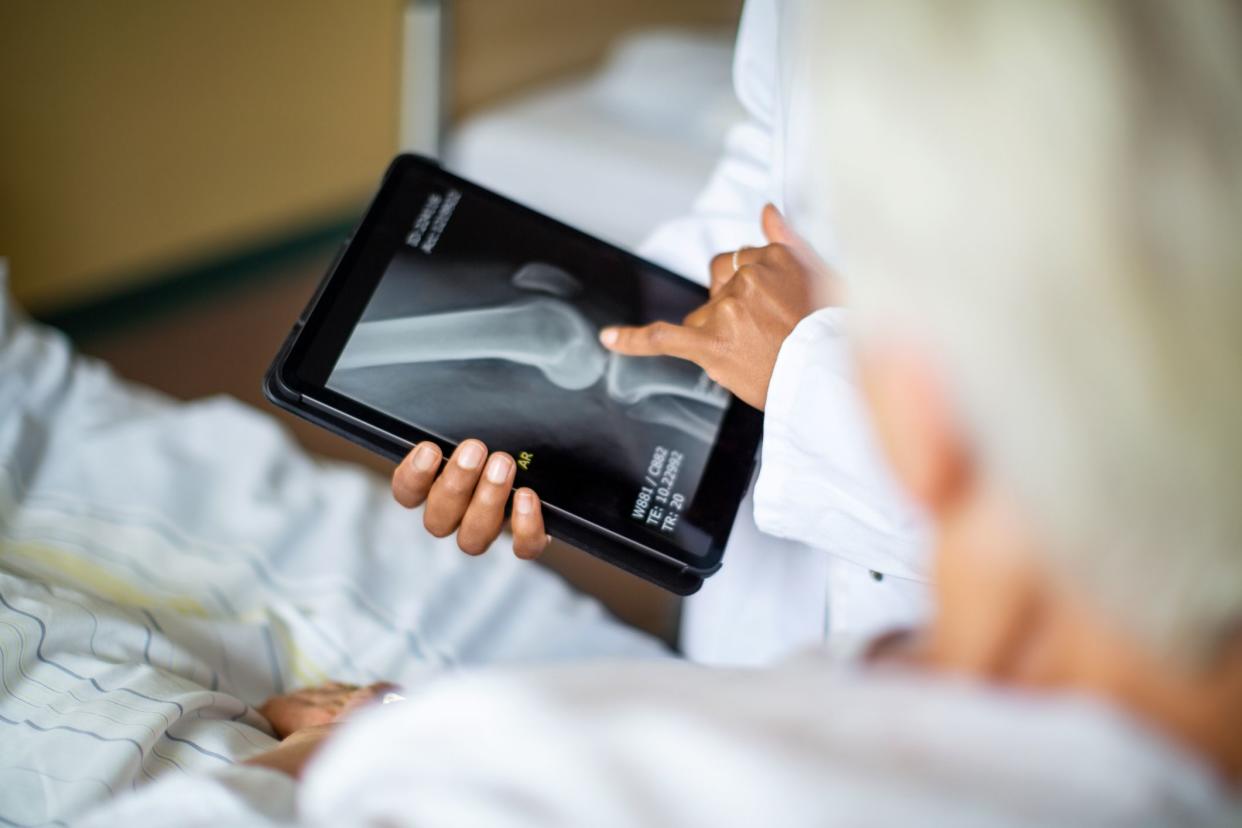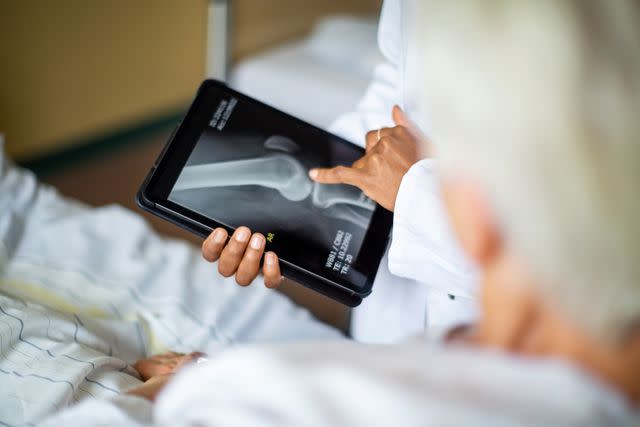How Estrogen Affects Osteoporosis and Bone Health

Luis Alvarez / Getty Images
Medically reviewed by Renita White, MD
Bone strength and health are important to mobility and function, especially as you age. Menopause is the natural end of fertility and officially begins one year after your last menstrual period. The exact timing varies but generally occurs between the ages of 45 and 55. During that time, hormone levels (including estrogen) slowly get lower.
Lower levels of estrogen in the menopausal transition can make you more vulnerable to osteoporosis—decreased bone mineral density and bone mass, causing thin and weak bones that are at risk for fracture. Osteoporosis is believed to affect about 1 in 5 women over the age of 50. There are ways to improve your bone health, even if your level of estrogen is decreasing.
This article discusses the role of estrogen in bone health, how low estrogen levels are related to osteoporosis, non-estrogen risk factors for osteoporosis, and osteoporosis prevention strategies including estrogen replacement therapy.

Luis Alvarez / Getty Images
Estrogen and Bone Health
Bone health changes throughout a person's lifetime. Bones grow stronger during adolescence, influenced by sex hormones (including estrogen and androgens) during puberty. Bones generally become their strongest around age 30. After that, bones slowly become thinner and weaker over time.
Bone density and strength are the results of diet, weight-bearing exercise, and hormones, in addition to genetics and other complex factors. Estrogen plays an important role in regulating bone health.
Estrogen inhibits the cells (osteoclasts) that break down bone. It reduces bone resorption by its effects on parathyroid hormone and calcitonin. Calcium is needed to build bone, and estrogen speeds up the absorption of calcium in the intestine and reduces calcium excretion.
Estrogen Fluctuations
If you have a menstrual cycle (period), you will typically experience natural estrogen level fluctuations throughout the month. As you approach menopause, it is natural for your estrogen levels to be lower. To complicate the situation, the ratio of your sex hormones may also change.
Low Estrogen Levels and Osteoporosis
During menopause, it is normal for the body to produce less estrogen. A decrease in estrogen levels can directly lead to lower bone mineral density (BMD) and an increased risk of fractures.
A 2015 study showed over a 10-year period, the participants lost a total of 9.1% BMD at the femoral neck and 10.6% BMD in the lumbar spine. Bone density can decrease even further as aging continues.
DEXA
Your provider may recommend a dual-energy X-ray absorptiometry (DEXA) assessment to check your bone density.
Early Menopause
Early menopause can have lasting consequences on your health, including greater rates of bone loss and lower BMD. If you experience early low estrogen levels or surgical removal of your ovaries, be sure to follow your healthcare provider's recommendations for bone density screenings. Ask any questions you have about your treatment options to optimize your bone health.
Other Risk Factors for Osteoporosis
Osteoporosis was considered a disease of aging for a long time. Now, there are ways to reduce the risk of brittle bones and new treatments that can help keep bones as strong as possible.
Speak with a healthcare provider if you have risk factors for osteoporosis. Some risk factors for developing osteoporosis include:
Female sex
Older age
Smaller or thinner body size (small skeleton)
Non-Hispanic White or Asian races
Family history (a parent who had osteoporosis or hip fractures)
Diet low in Vitamin D and calcium
Sedentary lifestyle with low physical activity level
Medications, including steroids, cancer treatments, and seizure medications like Dilantin (phenytoin)
This is a partial list of risks. Your provider may identify other risk factors in your personal health situation.
Preventing Osteoporosis Throughout Menopause
There is no guaranteed way to prevent osteoporosis, especially during and after menopause. The bone loss and damage of osteoporosis cannot be cured or reversed. However, there are several things you can do to maintain strong bones and prevent more bone loss.
A foundation of strong, healthy bones is built from puberty until about age 30. As much as possible, a nutritious diet with vitamin D and calcium gives you the building blocks to start with healthy bones. Activity, including weight-bearing exercise and strength training, helps build an extra reserve for the future.
There are several different treatments for osteoporosis. Your healthcare team will discuss with you the causes and recommendations for care given your situation.
Lifestyle modifications are steps you can take to help manage the course of your osteoporosis. Check with your healthcare provider to ensure these are safe for you, as there can be side effects even from these simple approaches:
Diet: A diet with adequate calcium, Vitamin D, and other vitamins and minerals is important to build bone.
Exercise: Weight-bearing and strength-training exercises can stimulate the bone to maintain strength and density
Medications, including bisphosphonates, may be recommended by your healthcare provider to help slow down bone loss. These are the drugs most often used to improve BMD, and can reduce hip fractures by up to 50% in some studies.
Even though these medications are effective, there is a low rate of taking the medication as directed (adherence). Cost, frequency, and rare but serious side effects may all play a role in your decision not to take the medication.
Estrogen-Replacement Therapy
Estrogen-replacement therapy is a type of hormone replacement therapy (HRT). It has been shown to reduce the risk of fracture and slow bone loss.
Estrogen replacement has many other potential benefits for people once they have reached menopause, including:
Reduced risk of heart disease
Protecting memory and brain function
Reduced hot flashes
Improving vaginal dryness
Related: Menopause, Osteoporosis, and Hormone Therapy
Risks and Side Effects
Estrogen therapy has complex effects on the body. There are some protective benefits with estrogen therapy, but there are also potential risks and side effects to consider. The specific medication, dose, duration of treatment, and other factors affect your risk level for side effects while taking estrogen. Possible side effects of treatment include:
Cancer (including breast, cervical, and uterine)
Risk-Benefit Statement
The 2022 hormone therapy position statement of the North American Menopause Society states the risk-benefit of estrogen therapy is most favorable within 10 years of menopause onset and for people under age 60. Your healthcare team will consider your individual condition and discuss the risks and benefits with you prior to recommending treatment.
When to See a Healthcare Provider
For many people, osteoporosis is a silent disease. Bones weaken over time, and you may not have any symptoms until your first fracture. Attending regular visits with your primary care provider, completing recommended screenings, eating a healthy diet, and exercising may help delay the onset or reduce the severity of brittle bones.
Be sure your provider knows if you have:
Early onset menopause or low estrogen
A parent with a hip fracture (especially from a standing height fall)
Taken corticosteroids for a prolonged time (usually months) for any condition
Summary
Menopause decreases your level of estrogen in the body, and this change can raise your risk for osteoporosis. Your bone density peaks around age 30, and there are ways you can help to preserve it as you age.
There are some medications that can help maintain bone health after menopause, but starting with strong bones and maintaining them is your best approach. Estrogen replacement is available for some people, but be sure to discuss the risks and benefits with your provider.
Frequently Asked Questions
When does menopause usually begin?
Menopause generally occurs in your early 50s. You are officially diagnosed with menopause when it has been one full year since your last menstrual period.
What can you do before menopause to lower your risk of osteoporosis?
Bone density typically peaks around the age of 30. Weight-bearing and resistance exercises can help build strong bones. Getting the right amounts of Vitamin D and calcium in your diet is crucial to being able to build bone.
How is osteoporosis diagnosed?
Osteoporosis is diagnosed by a bone density scan called DEXA (dual-energy X-ray absorptiometry). After your exam, you may receive a T-score that helps describe how far your bone density is from that of a healthy 30-year-old.

